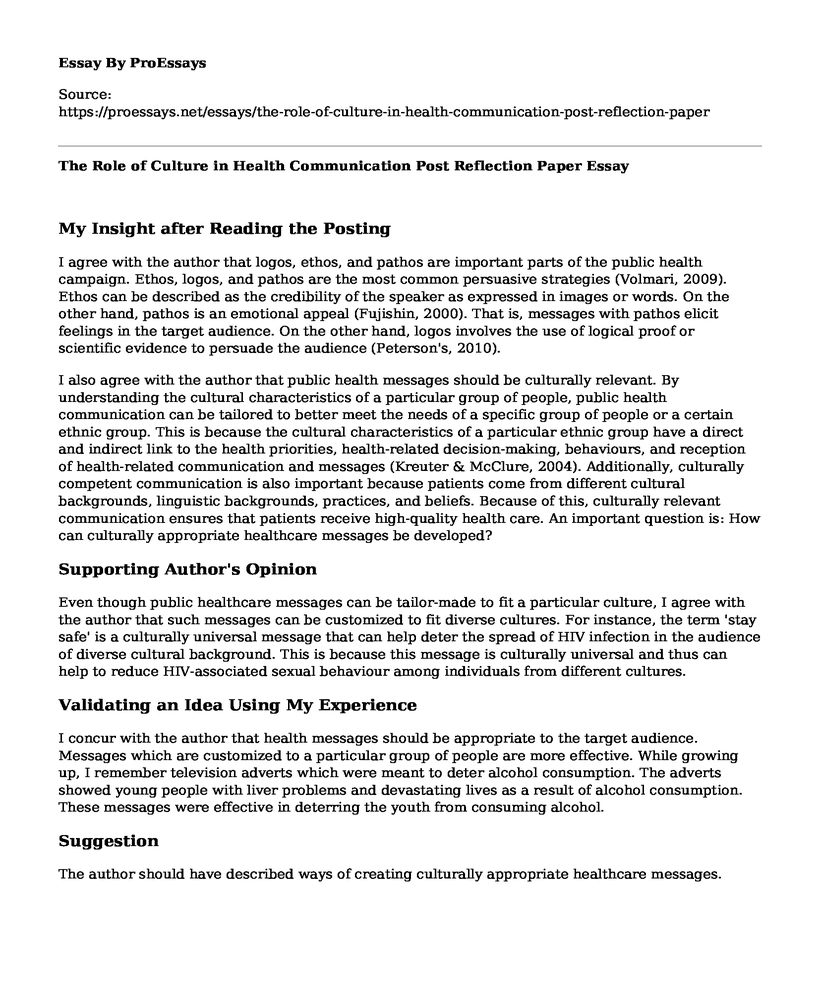My Insight after Reading the Posting
I agree with the author that logos, ethos, and pathos are important parts of the public health campaign. Ethos, logos, and pathos are the most common persuasive strategies (Volmari, 2009). Ethos can be described as the credibility of the speaker as expressed in images or words. On the other hand, pathos is an emotional appeal (Fujishin, 2000). That is, messages with pathos elicit feelings in the target audience. On the other hand, logos involves the use of logical proof or scientific evidence to persuade the audience (Peterson's, 2010).
I also agree with the author that public health messages should be culturally relevant. By understanding the cultural characteristics of a particular group of people, public health communication can be tailored to better meet the needs of a specific group of people or a certain ethnic group. This is because the cultural characteristics of a particular ethnic group have a direct and indirect link to the health priorities, health-related decision-making, behaviours, and reception of health-related communication and messages (Kreuter & McClure, 2004). Additionally, culturally competent communication is also important because patients come from different cultural backgrounds, linguistic backgrounds, practices, and beliefs. Because of this, culturally relevant communication ensures that patients receive high-quality health care. An important question is: How can culturally appropriate healthcare messages be developed?
Supporting Author's Opinion
Even though public healthcare messages can be tailor-made to fit a particular culture, I agree with the author that such messages can be customized to fit diverse cultures. For instance, the term 'stay safe' is a culturally universal message that can help deter the spread of HIV infection in the audience of diverse cultural background. This is because this message is culturally universal and thus can help to reduce HIV-associated sexual behaviour among individuals from different cultures.
Validating an Idea Using My Experience
I concur with the author that health messages should be appropriate to the target audience. Messages which are customized to a particular group of people are more effective. While growing up, I remember television adverts which were meant to deter alcohol consumption. The adverts showed young people with liver problems and devastating lives as a result of alcohol consumption. These messages were effective in deterring the youth from consuming alcohol.
Suggestion
The author should have described ways of creating culturally appropriate healthcare messages.
Expanding the Posting
What the author described as creating culturally relevant messages is part of what is referred to as audience segmentation. Kreuter and McClure (2004) further noted that health communication involves the process of dividing large and heterogeneous populations into small subgroups with homogeneous composition. This process is known as audience segmentation. When developing culturally relevant health messages, culture is a key audience-segmentation variable. According to Rimal et al. (2009), audience-segmentation is based on the idea that the target audience can be categorized into subgroups on the basis of an important underlying feature that renders the subgroups internally homogeneous in their reception of healthcare messages and campaigns. An important question in audience segmentation is: What are the key variables used to segment the audience?
References
Fujishin, R. (2000). Creating communication: exploring and expanding your fundamental communication skills. Rowman & Littlefield.
Kreuter, M. W., & McClure, S. M. (2004). The role of culture in health communication. Annu. Rev. Public Health, 25, 439-455.
Peterson's. (2010). Official guide to mastering the DSST-principles of public speaking: Chapter 6 of 8. Peterson's.
Rimal, R. N., Brown, J., Mkandawire, G., Folda, L., Bose, K., & Creel, A. H. (2009). Audience segmentation as a social-marketing tool in health promotion: use of the risk perception attitude framework in HIV prevention in Malawi. American Journal of Public Health, 99(12), 2224-2229. https://doi.org/10.2105/AJPH.2008.155234
Volmari, K. (2009). Half a century of forest industry rhetoric: persuasive strategies in sales augmentation. University of Vaasa.
Cite this page
The Role of Culture in Health Communication Post Reflection Paper. (2022, Jul 03). Retrieved from https://proessays.net/essays/the-role-of-culture-in-health-communication-post-reflection-paper
If you are the original author of this essay and no longer wish to have it published on the ProEssays website, please click below to request its removal:
- Research Paper Sample on New Jersey State Nurses Association
- Pro-Choice or Pro-Life: the Conundrum of Abortion. Critical Thinking Sample.
- Engagement With Physicians on Tuberculosis Screening Paper Example
- Visitors' Motivation for Attending Wine Festivals
- Nosocomial Infection Prevention: Evaluating the Health Belief Model - Research Paper
- Essay Sample on Global Pandemic: Effects on Learning, Transport, Business, & Entertainment
- Paper Example on Nursing: My Passion to Protect the Healthcare System







